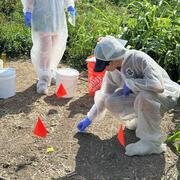The Southwest Biological Science Center:
Providing Unbiased Actionable Science & Information to Support Natural Resource Management Needs of the U.S. & Department of the Interior Priorities
A new app to report flash floods and debris flows in Grand Canyon
New backcountry alert system for the Grand Canyon
Visitors can subscribe to the alert system using satellite communication devices
Genetic divide among humpback chub in Grand Canyon?
The Southwest Fire Innovation Landscape Network
Advanced tools for fuel monitoring and assessment of wildfire risk
SBSC Science Informs Invasive Species Management
From efforts to deter smallmouth bass, predict insect invasions, and combat non-native plants — our science gives managers tools that lead to real on-the-ground results.
Southwest Energy Exploration
SBSC provides expertise and data to land managers to improve ecosystem services during and after energy development.
Southwest Biological Science Center
The SBSC provides sound science, specialized expertise, and objective and timely tools to Federal and State agencies and the public to inform land management decision-making, and support thriving landscapes for the Southwest’s abundant natural resources and vast public lands. This research assists those who manage, conserve, and rehabilitate rivers and arid regions of the nation.
Dryland Ecology and Management Support - the Terrestrial Drylands Ecology (TDE) branch of SBSC

SBSC conducts research in terrestrial drylands to deliver information that aids land & wildlife management to promote productive ecosystems. Our work provides tools used to mitigate impacts of drought, wildfire, and invasive species, as well as science that supports Department of the Interior economic and cultural activities including recreation and ranching.
Grand Canyon Monitoring and Research Center & Lake Powell research - the River Ecosystems branch of the SBSC

The SBSC Rivers branch, which includes the Grand Canyon Monitoring & Research Center, studies the biology, ecology, and processes of rivers, primarily in the SW. We provide the public and decision makers with relevant scientific information about the status and trends of natural, cultural, and recreational resources of the Colorado River in Grand Canyon, and Lake Powell.
Quick Links
- Learn how SBSC supports DOI priorities
- GCMRC science informs hydropower and invasive species management
- SBSC initiatives support ecosystems & economies on the Colorado Plateau
- Restoration Assessment & Monitoring Program for the Southwest (RAMPS)
- Outstanding in the Field podcasts
- The Southwest Repeat Photography Collection
- Our Staff Directory



